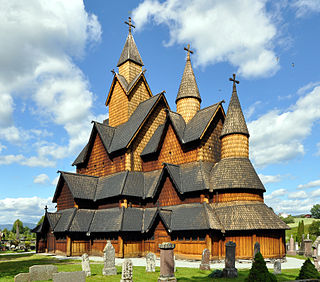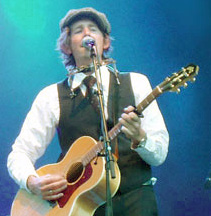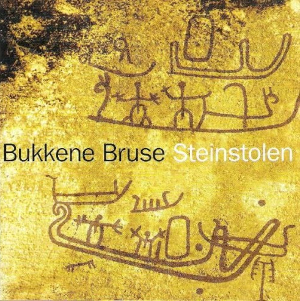Related Research Articles

Telemark is a county and a current electoral district in Norway. Telemark borders the counties of Vestfold, Buskerud, Vestland, Rogaland and Agder. In 2020, Telemark merged with the county of Vestfold to form the county of Vestfold og Telemark. On 1 January 2024, the county of Telemark was re-established after Vestfold og Telemark was divided again.

Eivind Groven was a Norwegian composer and music-theorist. He was from traditional region of Vest-Telemark and had a background in the folk music of the area.

A stave church is a medieval wooden Christian church building once common in north-western Europe. The name derives from the building's structure of post and lintel construction, a type of timber framing where the load-bearing ore-pine posts are called stafr in Old Norse. Two related church building types also named for their structural elements, the post church and palisade church, are often called 'stave churches'.

Bunad is a Norwegian umbrella term. In a broader sense, the term encompasses household, householding equipment, and livestock as well as both traditional rural clothes and modern 20th-century folk costumes. In its narrowest sense, the word bunad refers only to clothes designed in the early 20th century that are loosely based on traditional costumes.

Ellen Helen Nikolaysen is a Norwegian singer/actress. She participated in the Eurovision Song Contest in 1973 as part of the Bendik Singers group with the song It's Just A Game and Eurovision this time as a solo artist in 1975 with Touch My Life With Summer. She won the Best Performance Award at the World Popular Song Festival in Tokyo in 1974 with the entry "You Made Me Feel I Could Fly". In the early 1990s she began a new career as actor in musicals on Norwegian theatre stages.

Odd Nordstoga is a folk singer, musician, actor and editor from Vinje in Telemark, Norway. In 2004, he went from relative obscurity to becoming the country's biggest selling recording artist, with the phenomenal success of his first solo album proper, "Luring". The album, a fusion of pop and Norwegian folk music, has sold more than 160,000 copies in Norway to date and earned him several Spellemannsprisen awards. For the album Strålande Jul, released together with Sissel Kyrkjebø, he won an unprecedented 11 Norwegian platinum trophies.

Karin Fossum is a Norwegian author of crime fiction, often referred to as the "Norwegian queen of crime".

Steinstolen is the second album from Norwegian folk band Bukkene Bruse.

Magnus Grønneberg is the vocalist in the Norwegian rock band CC Cowboys. He has also developed his solo singing career.

The Brage Prize is a Norwegian literature prize that is awarded annually by the Norwegian Book Prize foundation. The prize recognizes recently published Norwegian literature.

Kim Bård Hansen, better known by his stage name Herodes Falsk, is a Norwegian comedian, actor, author, and songwriter. Falsk is probably best known for his work with the musical comedy trio Prima Vera alongside Jahn Teigen and Tom Mathisen, and for his longtime collaboration with Mathisen after Prima Vera's breakup in 1984. He is also often credited as Norway's first stand-up comedian.

Håvard Rem is a Norwegian poet.

Alf Cranner was a major Norwegian folk singer, lyricist and painter, considered by many to be the pioneer of the Norwegian folk music wave of the 1960s. The citation for the award of Evert Taube Memorial Fund Grant 1994, to Cranner states: «Det är motiverat att anse honom som sin tids fader för den norska viskonsten». He is known for several popular folk music interpretations and beautiful folk tunes, including these: Å, den som var en løvetann with lyrics by another great Norwegian folk singer and lyricist Alf Prøysen (1914–1970), Bare skrap and Den skamløse gamle damen with lyrics by Klaus Hagerup and Sjømannsvise with the text of Harald Sverdrup. Among Cranner folk songs with his own lyrics is Båt til lyst and Hambo i fellesferien two of the best known. The folk song Din tanke er fri, is Cranner translation of the German Die Gedanken sind frei.

Steinar Ofsdal is a Norwegian composer and flutist.
Halvor Johannesson Sandsdalen was a Norwegian farmer, journalist, poet, novelist, playwright and children's writer. He was also a proponent for Nynorsk, and a local politician.
Sondre Bratland is a Norwegian folk singer, song teacher and Government scholar. He has performed traditional songs from Setesdal and Telemark, collected religious folk tunes and composed music to songs by poets as Olav H. Hauge and Tarjei Vesaas. His album Pilegrimens Sangbog from 1982 earned him Spellemannprisen.

Svein Dag Hauge is a Norwegian jazz musician (guitar) and record producer, known from the band Lava and numerous recordings as a studio musician.
Roland og Magnus kongen literally "Roland and King Magnus," also known under the English title "Roland at the Battle of Roncevaux" is a Norwegian ballad about the legendary hero Roland of Charlemagne's court. The ballad is cataloged NMB 171, and categorized TSB type E 29. In the ballad, Roland's sword is compared to a sickle, its name corrupted to Dvælje=Dvolg, explained as meaning "dwarf-fiend" or "enemy of the dwarfs" Storm was of the opinion that the ballad could not be younger than the end of the 15th century, and Halvorsen also said it "must have been handed down orally since the late Middle Ages".
Ingebjørg Harman Bratland is a Norwegian folk singer, kveder and artist. In 2008–2009, she attended Foss Upper Secondary School in Oslo.

Øyonn Groven Myhren is a Norwegian traditional folk musician and kveder.
References
- ↑ Jacqueline Pattison Ekgren, Studia Musicologica Norvegica, Volume 27, Universitetsforlaget, 2001, p158.
- ↑ Dagne Groven Myhren ,Stev S.V.,Cappelens Musikkleksikon 1981, Cappelen, 1981, Column no.3(paragraph no.4)
- 1 2 no:Stev
- ↑ Lystrup, Geirr (1980). Skjemteviser og salmevers. p. 7. ISBN 82-521-1849-6.
Nystevet er det norsk motstykket til amerikanarane sin blues. Steva uttrykkjer kjærleik eller og lengt, men dei kan også vera skjemtande eller forma slik at dei skal ramme ein annan på eit sårt punkt.
- 1 2 3 Ekgren, Jacqueline Pattison (2009). "12. Dipod rules: Norwegian stev paired accents and accentual poetry". Berkeley Insights in Linguistics and Semiotics. 74: 207.
- ↑ Ekgren, Jacqueline Pattison (2009). "12. Dipod rules: Norwegian stev paired accents and accentual poetry". Berkeley Insights in Linguistics and Semiotics. 74: 208.
- ↑ Lystrup, Geirr (1980). Skjemteviser og salmevers. p. 7. ISBN 82-521-1849-6.
I eldre tider var det sjølvsagt at ein god kvedar kunne stevje,
- ↑ Lystrup, Geirr (1980). Skjemteviser og salmevers. p. 7. ISBN 82-521-1849-6.
Å stevjast er ei selskapeleg form for songkamp, og det gjeld å kunne flest mogleg stev slik at ein aldri er opprådd.
- 1 2 Dagne Groven Myhren, Stev S.V.,Cappelens Musikkleksikon 1 981, Cappelen, 1981, Column no.5
- 1 2 Aslan Farschian (2011-10-11). Verdens Gang . p. Sporten 7.
Han fikk selv klokken borte mot Jugoslavia i 1983. Norge tapte 2-1, men banketten etterpå husker Hareide godt. — – Vi hadde spist noe lammekjøtt og Svein Mathisen hadde vært inne på kjøkkenet og hentet et sauehode! Han tok det med inn der vi spiste, gikk opp på bordet og fremførte et stev fra Telemark for meg. Svein var god på stev, forteller Hareide.
{{cite news}}: Missing or empty|title=(help)